PPMP20008 Project Plan: Indigenous Cultural Awareness Training for CQU
VerifiedAdded on 2023/06/08
|20
|3340
|245
Project
AI Summary
This project plan outlines the development of an indigenous cultural awareness training program for Central Queensland University (CQU), initiated by the School of Engineering and Technology (SET) Indigenisation Committee. The project aims to enhance understanding of indigenous history, culture, languages, and protocols among CQU students and staff, aligning with NAIDOC week. The plan includes a project description, justification using a Prince2 flow diagram, stakeholder analysis with engagement assessment matrices, communication strategies, requirements management covering traditional land ownership, opening statements, and requirements gathering and prioritization using MoSCoW technique, and scope definition with work breakdown structure (WBS) and dictionary. It also presents a project schedule with key activities and timelines. The project's goal is to foster a more inclusive and culturally aware environment within the university.
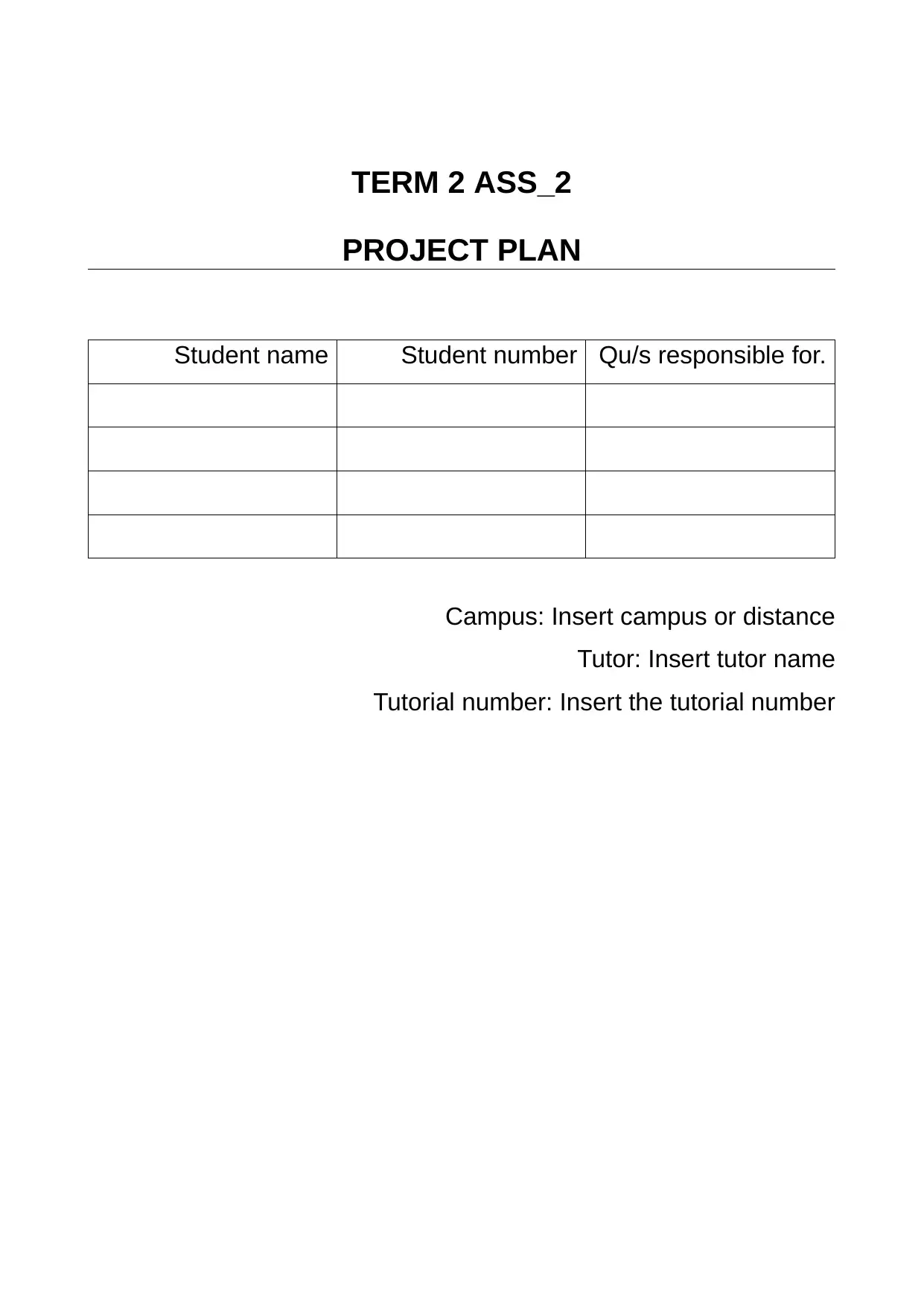
TERM 2 ASS_2
PROJECT PLAN
Student name Student number Qu/s responsible for.
Campus: Insert campus or distance
Tutor: Insert tutor name
Tutorial number: Insert the tutorial number
PROJECT PLAN
Student name Student number Qu/s responsible for.
Campus: Insert campus or distance
Tutor: Insert tutor name
Tutorial number: Insert the tutorial number
Paraphrase This Document
Need a fresh take? Get an instant paraphrase of this document with our AI Paraphraser
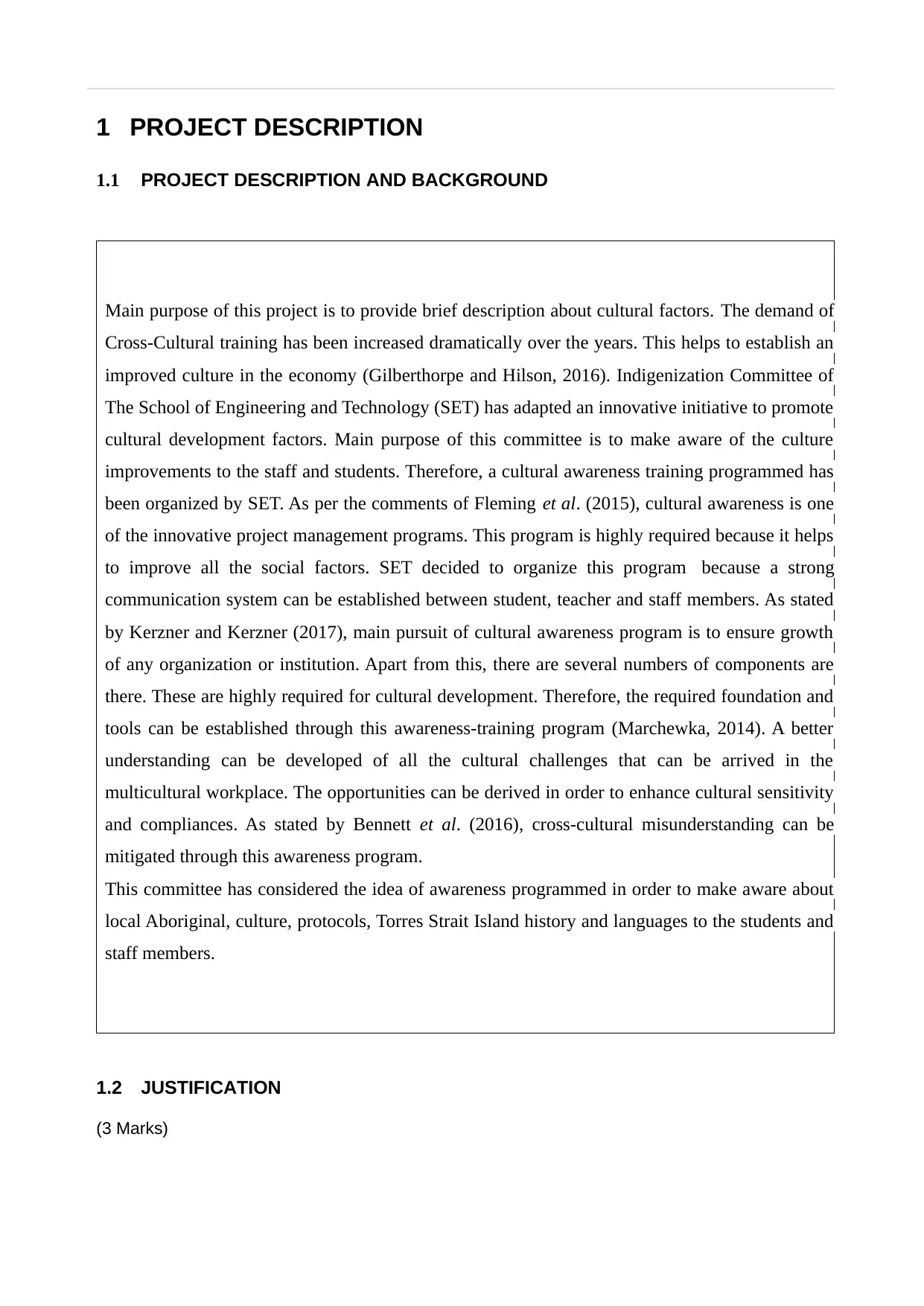
1 PROJECT DESCRIPTION
1.1 PROJECT DESCRIPTION AND BACKGROUND
Main purpose of this project is to provide brief description about cultural factors. The demand of
Cross-Cultural training has been increased dramatically over the years. This helps to establish an
improved culture in the economy (Gilberthorpe and Hilson, 2016). Indigenization Committee of
The School of Engineering and Technology (SET) has adapted an innovative initiative to promote
cultural development factors. Main purpose of this committee is to make aware of the culture
improvements to the staff and students. Therefore, a cultural awareness training programmed has
been organized by SET. As per the comments of Fleming et al. (2015), cultural awareness is one
of the innovative project management programs. This program is highly required because it helps
to improve all the social factors. SET decided to organize this program because a strong
communication system can be established between student, teacher and staff members. As stated
by Kerzner and Kerzner (2017), main pursuit of cultural awareness program is to ensure growth
of any organization or institution. Apart from this, there are several numbers of components are
there. These are highly required for cultural development. Therefore, the required foundation and
tools can be established through this awareness-training program (Marchewka, 2014). A better
understanding can be developed of all the cultural challenges that can be arrived in the
multicultural workplace. The opportunities can be derived in order to enhance cultural sensitivity
and compliances. As stated by Bennett et al. (2016), cross-cultural misunderstanding can be
mitigated through this awareness program.
This committee has considered the idea of awareness programmed in order to make aware about
local Aboriginal, culture, protocols, Torres Strait Island history and languages to the students and
staff members.
1.2 JUSTIFICATION
(3 Marks)
1.1 PROJECT DESCRIPTION AND BACKGROUND
Main purpose of this project is to provide brief description about cultural factors. The demand of
Cross-Cultural training has been increased dramatically over the years. This helps to establish an
improved culture in the economy (Gilberthorpe and Hilson, 2016). Indigenization Committee of
The School of Engineering and Technology (SET) has adapted an innovative initiative to promote
cultural development factors. Main purpose of this committee is to make aware of the culture
improvements to the staff and students. Therefore, a cultural awareness training programmed has
been organized by SET. As per the comments of Fleming et al. (2015), cultural awareness is one
of the innovative project management programs. This program is highly required because it helps
to improve all the social factors. SET decided to organize this program because a strong
communication system can be established between student, teacher and staff members. As stated
by Kerzner and Kerzner (2017), main pursuit of cultural awareness program is to ensure growth
of any organization or institution. Apart from this, there are several numbers of components are
there. These are highly required for cultural development. Therefore, the required foundation and
tools can be established through this awareness-training program (Marchewka, 2014). A better
understanding can be developed of all the cultural challenges that can be arrived in the
multicultural workplace. The opportunities can be derived in order to enhance cultural sensitivity
and compliances. As stated by Bennett et al. (2016), cross-cultural misunderstanding can be
mitigated through this awareness program.
This committee has considered the idea of awareness programmed in order to make aware about
local Aboriginal, culture, protocols, Torres Strait Island history and languages to the students and
staff members.
1.2 JUSTIFICATION
(3 Marks)
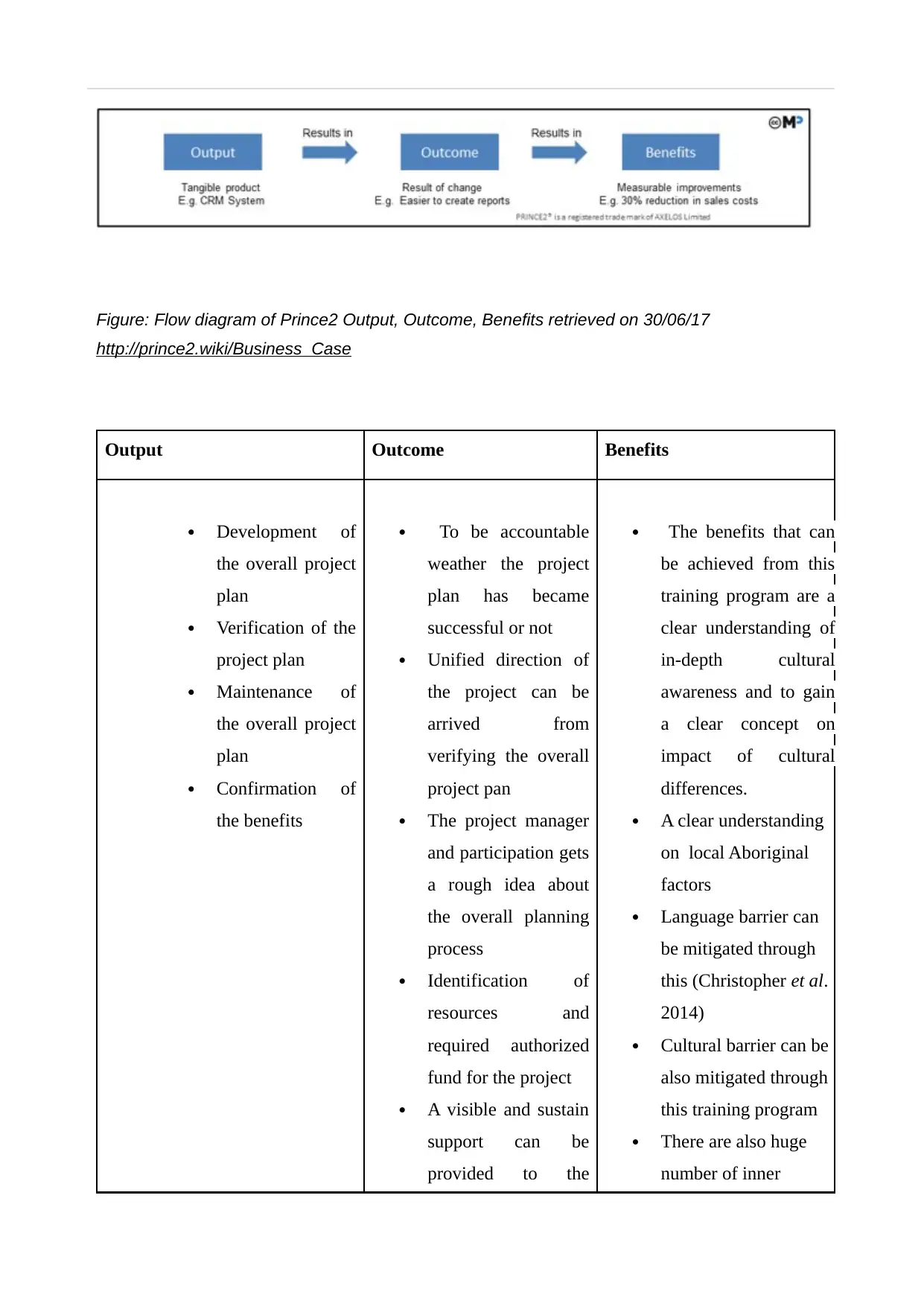
Figure: Flow diagram of Prince2 Output, Outcome, Benefits retrieved on 30/06/17
http://prince2.wiki/Business_Case
Output Outcome Benefits
Development of
the overall project
plan
Verification of the
project plan
Maintenance of
the overall project
plan
Confirmation of
the benefits
To be accountable
weather the project
plan has became
successful or not
Unified direction of
the project can be
arrived from
verifying the overall
project pan
The project manager
and participation gets
a rough idea about
the overall planning
process
Identification of
resources and
required authorized
fund for the project
A visible and sustain
support can be
provided to the
The benefits that can
be achieved from this
training program are a
clear understanding of
in-depth cultural
awareness and to gain
a clear concept on
impact of cultural
differences.
A clear understanding
on local Aboriginal
factors
Language barrier can
be mitigated through
this (Christopher et al.
2014)
Cultural barrier can be
also mitigated through
this training program
There are also huge
number of inner
http://prince2.wiki/Business_Case
Output Outcome Benefits
Development of
the overall project
plan
Verification of the
project plan
Maintenance of
the overall project
plan
Confirmation of
the benefits
To be accountable
weather the project
plan has became
successful or not
Unified direction of
the project can be
arrived from
verifying the overall
project pan
The project manager
and participation gets
a rough idea about
the overall planning
process
Identification of
resources and
required authorized
fund for the project
A visible and sustain
support can be
provided to the
The benefits that can
be achieved from this
training program are a
clear understanding of
in-depth cultural
awareness and to gain
a clear concept on
impact of cultural
differences.
A clear understanding
on local Aboriginal
factors
Language barrier can
be mitigated through
this (Christopher et al.
2014)
Cultural barrier can be
also mitigated through
this training program
There are also huge
number of inner
⊘ This is a preview!⊘
Do you want full access?
Subscribe today to unlock all pages.

Trusted by 1+ million students worldwide
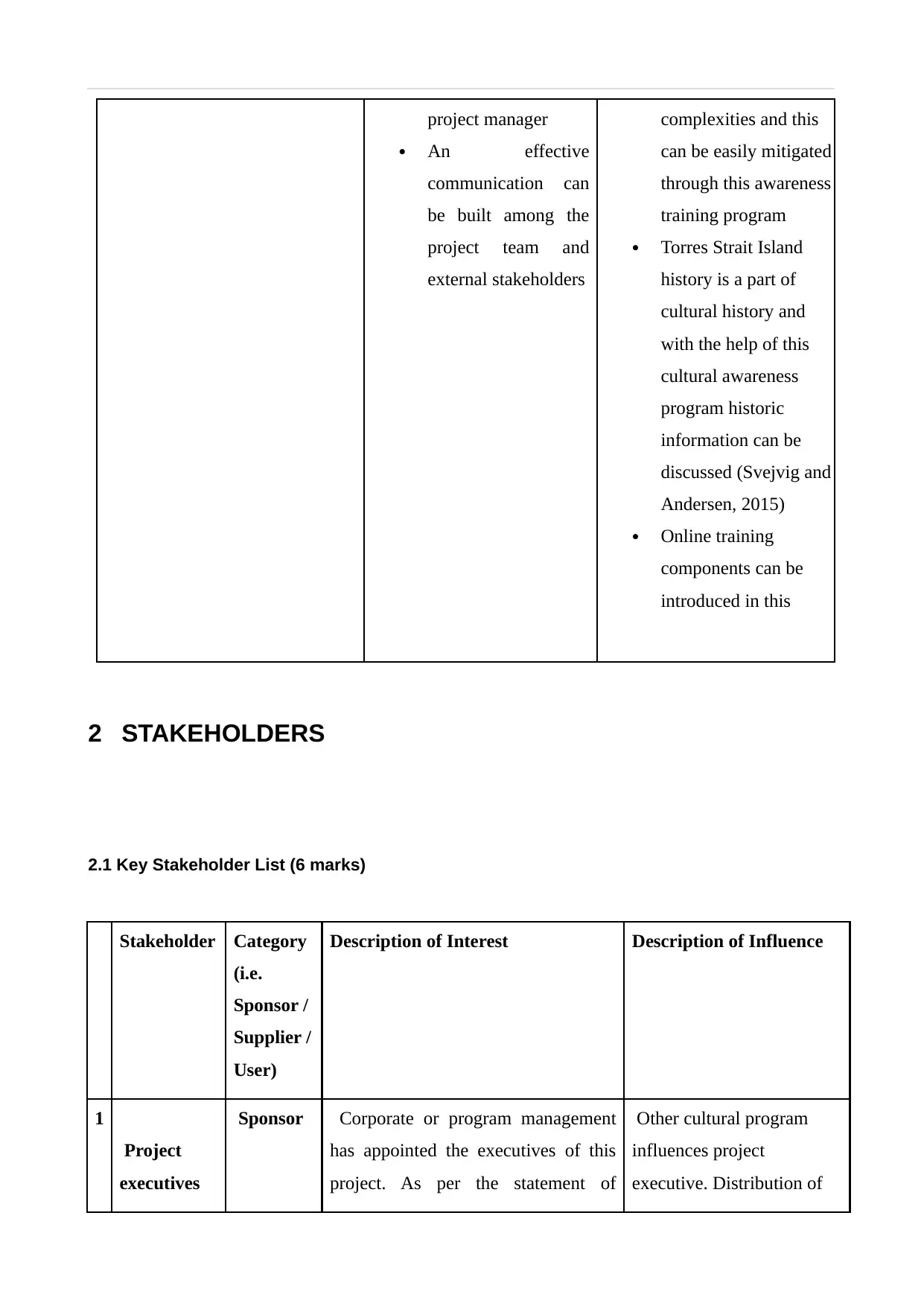
project manager
An effective
communication can
be built among the
project team and
external stakeholders
complexities and this
can be easily mitigated
through this awareness
training program
Torres Strait Island
history is a part of
cultural history and
with the help of this
cultural awareness
program historic
information can be
discussed (Svejvig and
Andersen, 2015)
Online training
components can be
introduced in this
2 STAKEHOLDERS
2.1 Key Stakeholder List (6 marks)
Stakeholder Category
(i.e.
Sponsor /
Supplier /
User)
Description of Interest Description of Influence
1
Project
executives
Sponsor Corporate or program management
has appointed the executives of this
project. As per the statement of
Other cultural program
influences project
executive. Distribution of
An effective
communication can
be built among the
project team and
external stakeholders
complexities and this
can be easily mitigated
through this awareness
training program
Torres Strait Island
history is a part of
cultural history and
with the help of this
cultural awareness
program historic
information can be
discussed (Svejvig and
Andersen, 2015)
Online training
components can be
introduced in this
2 STAKEHOLDERS
2.1 Key Stakeholder List (6 marks)
Stakeholder Category
(i.e.
Sponsor /
Supplier /
User)
Description of Interest Description of Influence
1
Project
executives
Sponsor Corporate or program management
has appointed the executives of this
project. As per the statement of
Other cultural program
influences project
executive. Distribution of
Paraphrase This Document
Need a fresh take? Get an instant paraphrase of this document with our AI Paraphraser
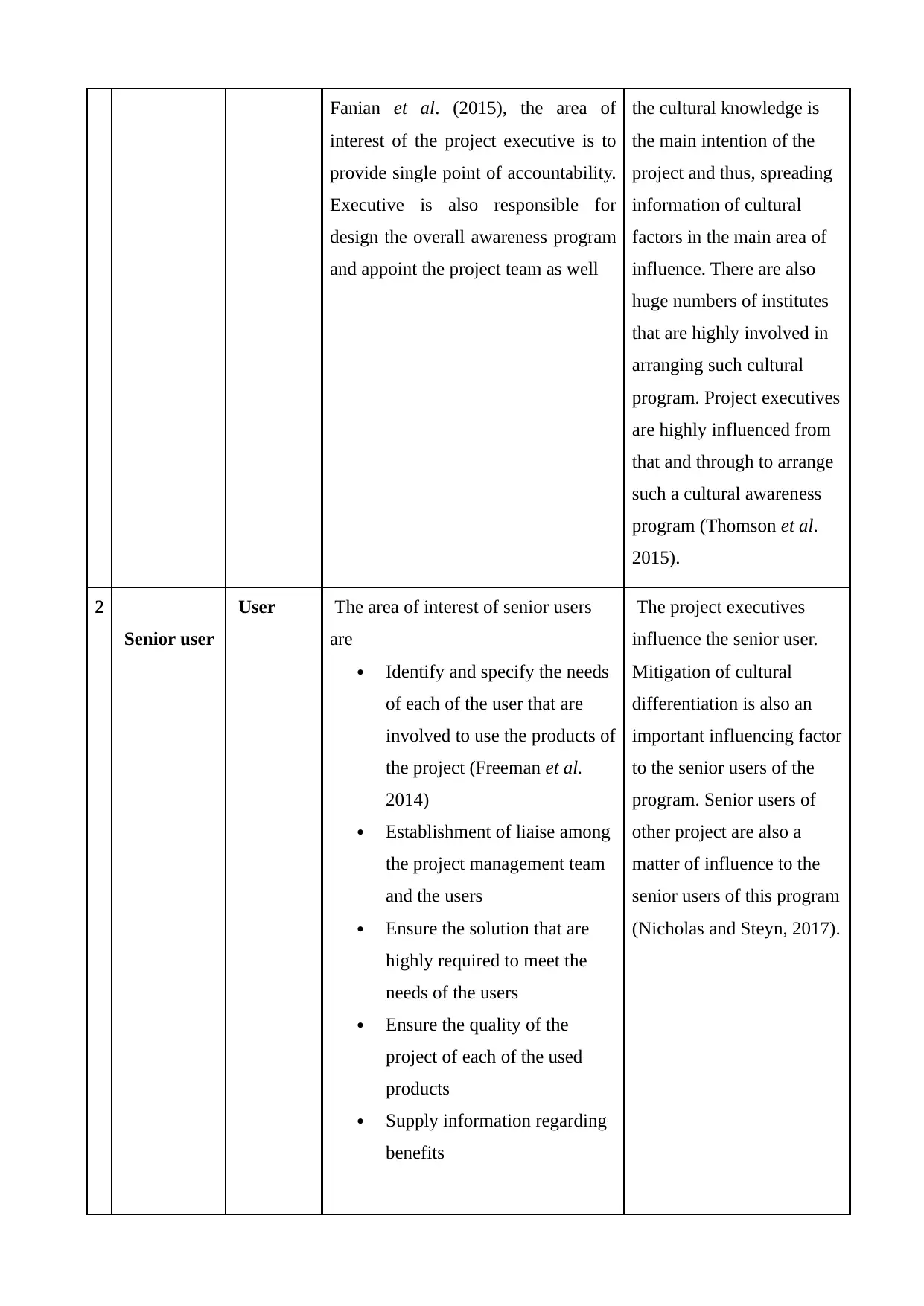
Fanian et al. (2015), the area of
interest of the project executive is to
provide single point of accountability.
Executive is also responsible for
design the overall awareness program
and appoint the project team as well
the cultural knowledge is
the main intention of the
project and thus, spreading
information of cultural
factors in the main area of
influence. There are also
huge numbers of institutes
that are highly involved in
arranging such cultural
program. Project executives
are highly influenced from
that and through to arrange
such a cultural awareness
program (Thomson et al.
2015).
2
Senior user
User The area of interest of senior users
are
Identify and specify the needs
of each of the user that are
involved to use the products of
the project (Freeman et al.
2014)
Establishment of liaise among
the project management team
and the users
Ensure the solution that are
highly required to meet the
needs of the users
Ensure the quality of the
project of each of the used
products
Supply information regarding
benefits
The project executives
influence the senior user.
Mitigation of cultural
differentiation is also an
important influencing factor
to the senior users of the
program. Senior users of
other project are also a
matter of influence to the
senior users of this program
(Nicholas and Steyn, 2017).
interest of the project executive is to
provide single point of accountability.
Executive is also responsible for
design the overall awareness program
and appoint the project team as well
the cultural knowledge is
the main intention of the
project and thus, spreading
information of cultural
factors in the main area of
influence. There are also
huge numbers of institutes
that are highly involved in
arranging such cultural
program. Project executives
are highly influenced from
that and through to arrange
such a cultural awareness
program (Thomson et al.
2015).
2
Senior user
User The area of interest of senior users
are
Identify and specify the needs
of each of the user that are
involved to use the products of
the project (Freeman et al.
2014)
Establishment of liaise among
the project management team
and the users
Ensure the solution that are
highly required to meet the
needs of the users
Ensure the quality of the
project of each of the used
products
Supply information regarding
benefits
The project executives
influence the senior user.
Mitigation of cultural
differentiation is also an
important influencing factor
to the senior users of the
program. Senior users of
other project are also a
matter of influence to the
senior users of this program
(Nicholas and Steyn, 2017).
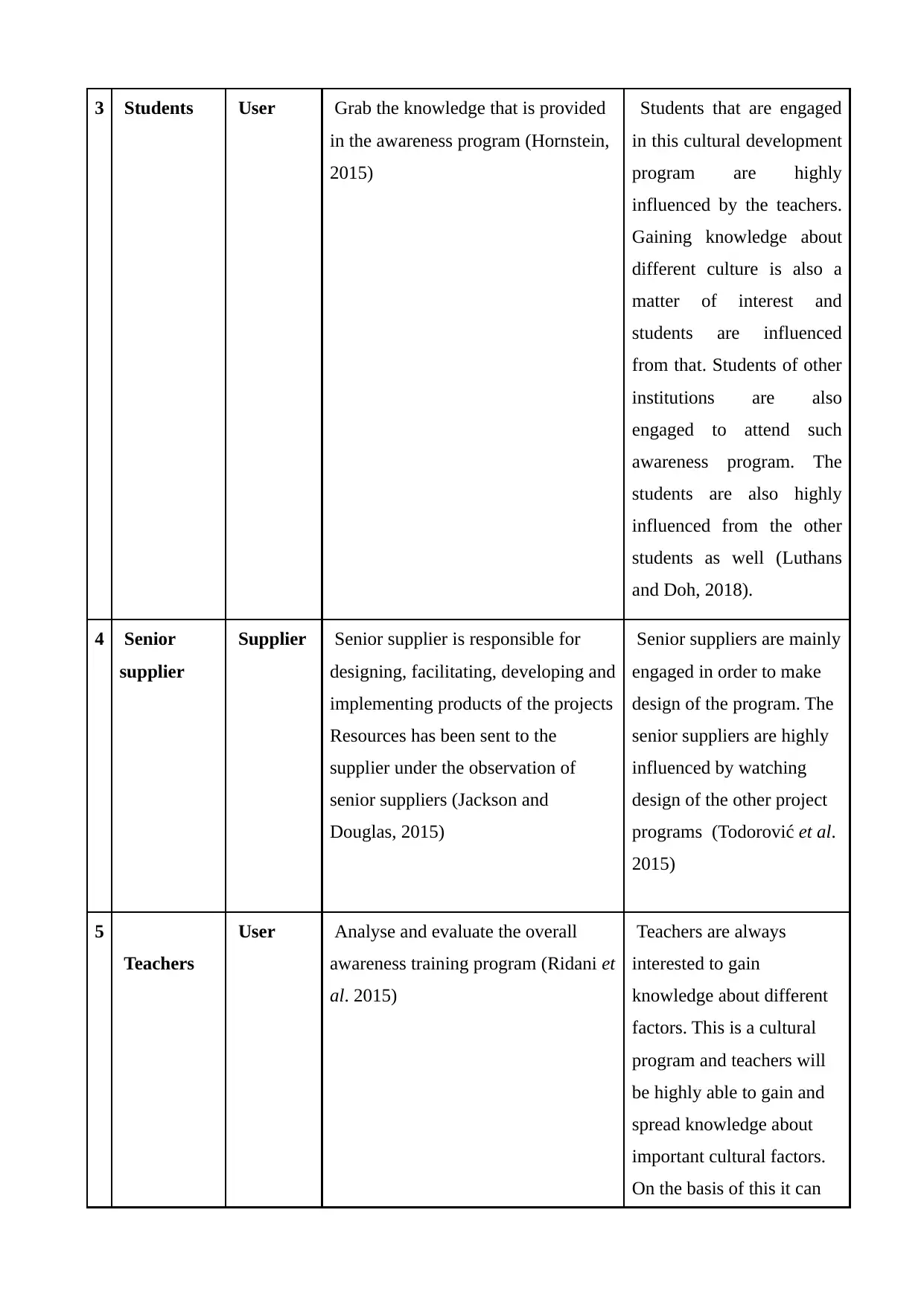
3 Students User Grab the knowledge that is provided
in the awareness program (Hornstein,
2015)
Students that are engaged
in this cultural development
program are highly
influenced by the teachers.
Gaining knowledge about
different culture is also a
matter of interest and
students are influenced
from that. Students of other
institutions are also
engaged to attend such
awareness program. The
students are also highly
influenced from the other
students as well (Luthans
and Doh, 2018).
4 Senior
supplier
Supplier Senior supplier is responsible for
designing, facilitating, developing and
implementing products of the projects
Resources has been sent to the
supplier under the observation of
senior suppliers (Jackson and
Douglas, 2015)
Senior suppliers are mainly
engaged in order to make
design of the program. The
senior suppliers are highly
influenced by watching
design of the other project
programs (Todorović et al.
2015)
5
Teachers
User Analyse and evaluate the overall
awareness training program (Ridani et
al. 2015)
Teachers are always
interested to gain
knowledge about different
factors. This is a cultural
program and teachers will
be highly able to gain and
spread knowledge about
important cultural factors.
On the basis of this it can
in the awareness program (Hornstein,
2015)
Students that are engaged
in this cultural development
program are highly
influenced by the teachers.
Gaining knowledge about
different culture is also a
matter of interest and
students are influenced
from that. Students of other
institutions are also
engaged to attend such
awareness program. The
students are also highly
influenced from the other
students as well (Luthans
and Doh, 2018).
4 Senior
supplier
Supplier Senior supplier is responsible for
designing, facilitating, developing and
implementing products of the projects
Resources has been sent to the
supplier under the observation of
senior suppliers (Jackson and
Douglas, 2015)
Senior suppliers are mainly
engaged in order to make
design of the program. The
senior suppliers are highly
influenced by watching
design of the other project
programs (Todorović et al.
2015)
5
Teachers
User Analyse and evaluate the overall
awareness training program (Ridani et
al. 2015)
Teachers are always
interested to gain
knowledge about different
factors. This is a cultural
program and teachers will
be highly able to gain and
spread knowledge about
important cultural factors.
On the basis of this it can
⊘ This is a preview!⊘
Do you want full access?
Subscribe today to unlock all pages.

Trusted by 1+ million students worldwide
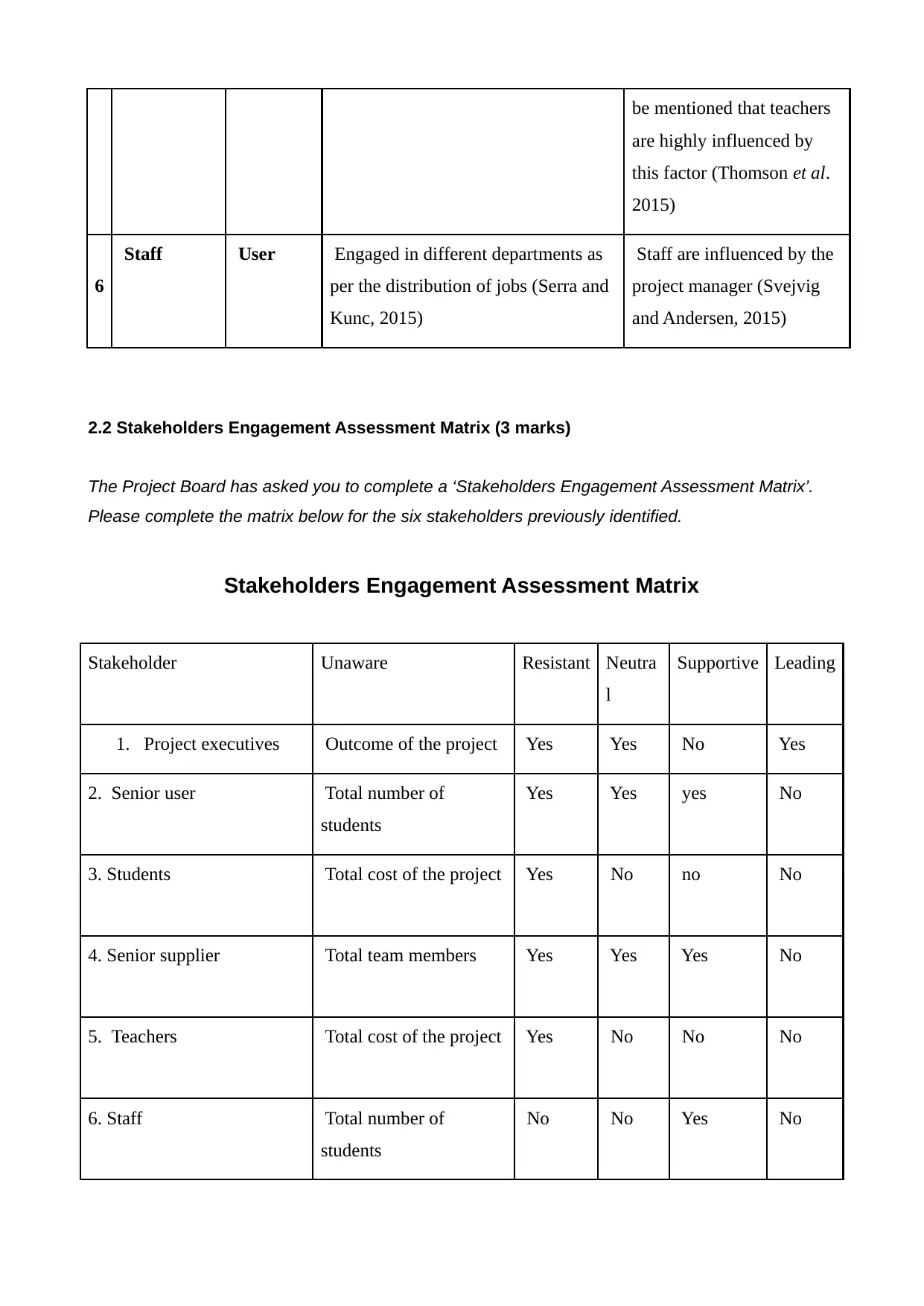
be mentioned that teachers
are highly influenced by
this factor (Thomson et al.
2015)
6
Staff User Engaged in different departments as
per the distribution of jobs (Serra and
Kunc, 2015)
Staff are influenced by the
project manager (Svejvig
and Andersen, 2015)
2.2 Stakeholders Engagement Assessment Matrix (3 marks)
The Project Board has asked you to complete a ‘Stakeholders Engagement Assessment Matrix’.
Please complete the matrix below for the six stakeholders previously identified.
Stakeholders Engagement Assessment Matrix
Stakeholder Unaware Resistant Neutra
l
Supportive Leading
1. Project executives Outcome of the project Yes Yes No Yes
2. Senior user Total number of
students
Yes Yes yes No
3. Students Total cost of the project Yes No no No
4. Senior supplier Total team members Yes Yes Yes No
5. Teachers Total cost of the project Yes No No No
6. Staff Total number of
students
No No Yes No
are highly influenced by
this factor (Thomson et al.
2015)
6
Staff User Engaged in different departments as
per the distribution of jobs (Serra and
Kunc, 2015)
Staff are influenced by the
project manager (Svejvig
and Andersen, 2015)
2.2 Stakeholders Engagement Assessment Matrix (3 marks)
The Project Board has asked you to complete a ‘Stakeholders Engagement Assessment Matrix’.
Please complete the matrix below for the six stakeholders previously identified.
Stakeholders Engagement Assessment Matrix
Stakeholder Unaware Resistant Neutra
l
Supportive Leading
1. Project executives Outcome of the project Yes Yes No Yes
2. Senior user Total number of
students
Yes Yes yes No
3. Students Total cost of the project Yes No no No
4. Senior supplier Total team members Yes Yes Yes No
5. Teachers Total cost of the project Yes No No No
6. Staff Total number of
students
No No Yes No
Paraphrase This Document
Need a fresh take? Get an instant paraphrase of this document with our AI Paraphraser
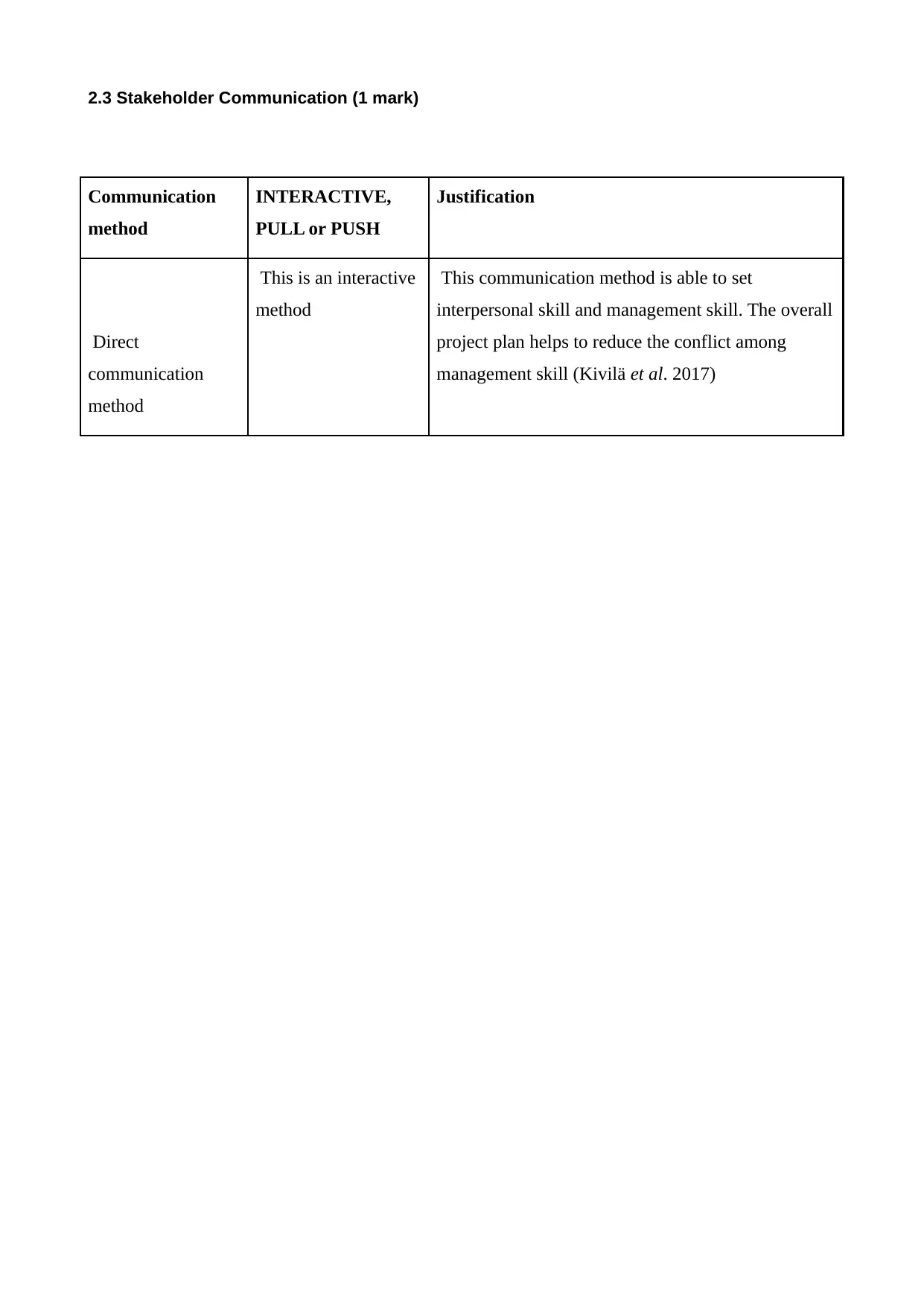
2.3 Stakeholder Communication (1 mark)
Communication
method
INTERACTIVE,
PULL or PUSH
Justification
Direct
communication
method
This is an interactive
method
This communication method is able to set
interpersonal skill and management skill. The overall
project plan helps to reduce the conflict among
management skill (Kivilä et al. 2017)
Communication
method
INTERACTIVE,
PULL or PUSH
Justification
Direct
communication
method
This is an interactive
method
This communication method is able to set
interpersonal skill and management skill. The overall
project plan helps to reduce the conflict among
management skill (Kivilä et al. 2017)
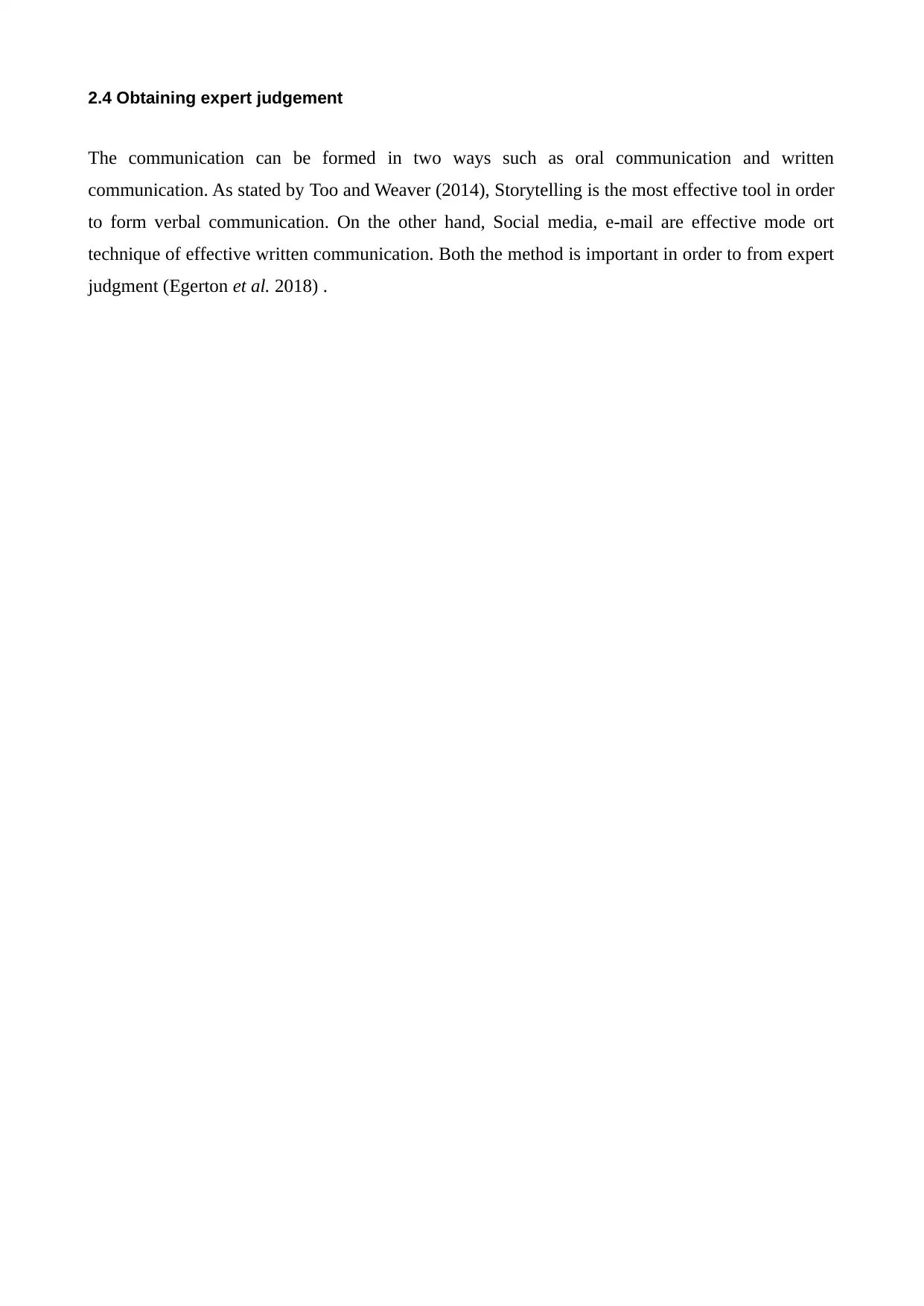
2.4 Obtaining expert judgement
The communication can be formed in two ways such as oral communication and written
communication. As stated by Too and Weaver (2014), Storytelling is the most effective tool in order
to form verbal communication. On the other hand, Social media, e-mail are effective mode ort
technique of effective written communication. Both the method is important in order to from expert
judgment (Egerton et al. 2018) .
The communication can be formed in two ways such as oral communication and written
communication. As stated by Too and Weaver (2014), Storytelling is the most effective tool in order
to form verbal communication. On the other hand, Social media, e-mail are effective mode ort
technique of effective written communication. Both the method is important in order to from expert
judgment (Egerton et al. 2018) .
⊘ This is a preview!⊘
Do you want full access?
Subscribe today to unlock all pages.

Trusted by 1+ million students worldwide
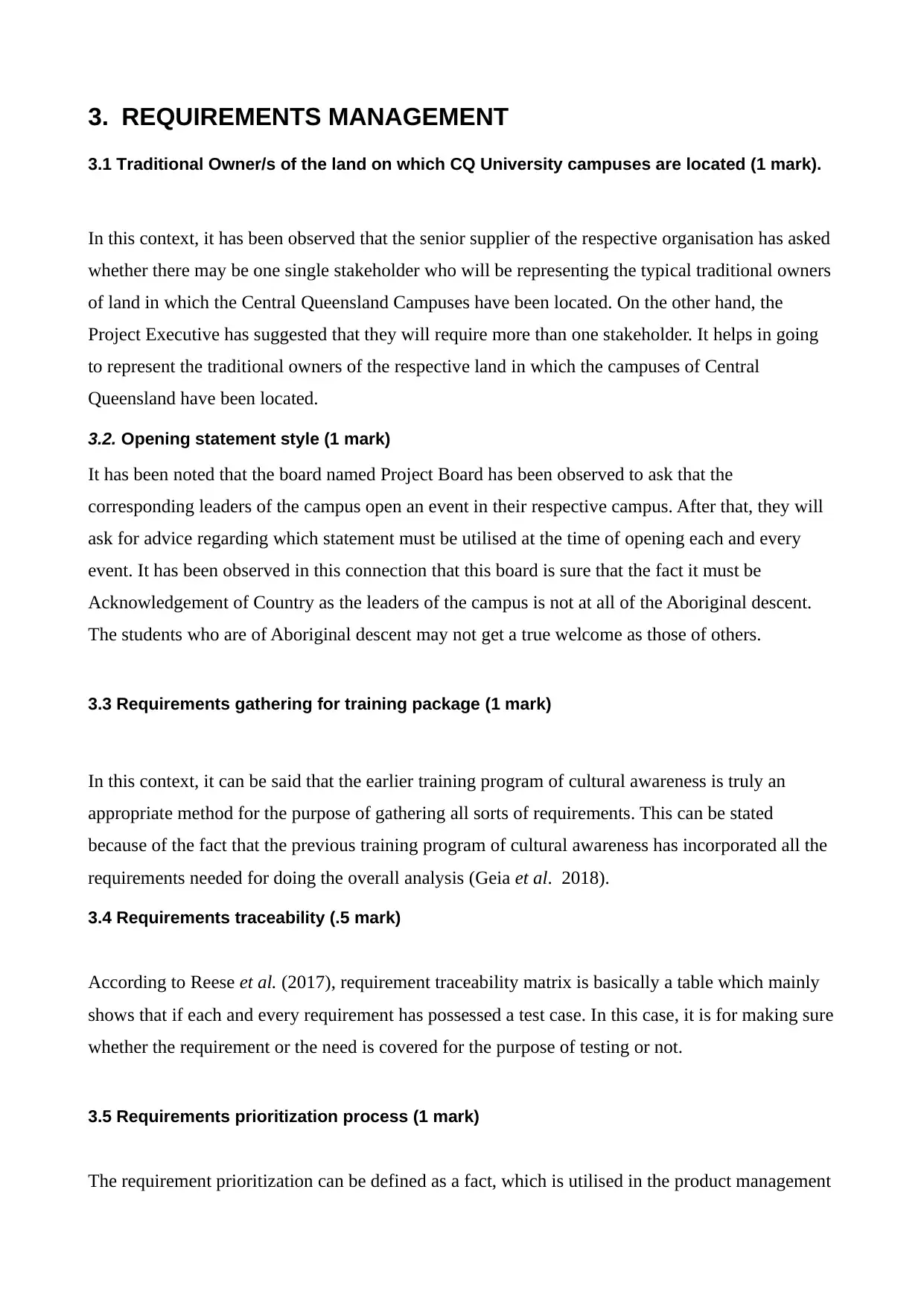
3. REQUIREMENTS MANAGEMENT
3.1 Traditional Owner/s of the land on which CQ University campuses are located (1 mark).
In this context, it has been observed that the senior supplier of the respective organisation has asked
whether there may be one single stakeholder who will be representing the typical traditional owners
of land in which the Central Queensland Campuses have been located. On the other hand, the
Project Executive has suggested that they will require more than one stakeholder. It helps in going
to represent the traditional owners of the respective land in which the campuses of Central
Queensland have been located.
3.2. Opening statement style (1 mark)
It has been noted that the board named Project Board has been observed to ask that the
corresponding leaders of the campus open an event in their respective campus. After that, they will
ask for advice regarding which statement must be utilised at the time of opening each and every
event. It has been observed in this connection that this board is sure that the fact it must be
Acknowledgement of Country as the leaders of the campus is not at all of the Aboriginal descent.
The students who are of Aboriginal descent may not get a true welcome as those of others.
3.3 Requirements gathering for training package (1 mark)
In this context, it can be said that the earlier training program of cultural awareness is truly an
appropriate method for the purpose of gathering all sorts of requirements. This can be stated
because of the fact that the previous training program of cultural awareness has incorporated all the
requirements needed for doing the overall analysis (Geia et al. 2018).
3.4 Requirements traceability (.5 mark)
According to Reese et al. (2017), requirement traceability matrix is basically a table which mainly
shows that if each and every requirement has possessed a test case. In this case, it is for making sure
whether the requirement or the need is covered for the purpose of testing or not.
3.5 Requirements prioritization process (1 mark)
The requirement prioritization can be defined as a fact, which is utilised in the product management
3.1 Traditional Owner/s of the land on which CQ University campuses are located (1 mark).
In this context, it has been observed that the senior supplier of the respective organisation has asked
whether there may be one single stakeholder who will be representing the typical traditional owners
of land in which the Central Queensland Campuses have been located. On the other hand, the
Project Executive has suggested that they will require more than one stakeholder. It helps in going
to represent the traditional owners of the respective land in which the campuses of Central
Queensland have been located.
3.2. Opening statement style (1 mark)
It has been noted that the board named Project Board has been observed to ask that the
corresponding leaders of the campus open an event in their respective campus. After that, they will
ask for advice regarding which statement must be utilised at the time of opening each and every
event. It has been observed in this connection that this board is sure that the fact it must be
Acknowledgement of Country as the leaders of the campus is not at all of the Aboriginal descent.
The students who are of Aboriginal descent may not get a true welcome as those of others.
3.3 Requirements gathering for training package (1 mark)
In this context, it can be said that the earlier training program of cultural awareness is truly an
appropriate method for the purpose of gathering all sorts of requirements. This can be stated
because of the fact that the previous training program of cultural awareness has incorporated all the
requirements needed for doing the overall analysis (Geia et al. 2018).
3.4 Requirements traceability (.5 mark)
According to Reese et al. (2017), requirement traceability matrix is basically a table which mainly
shows that if each and every requirement has possessed a test case. In this case, it is for making sure
whether the requirement or the need is covered for the purpose of testing or not.
3.5 Requirements prioritization process (1 mark)
The requirement prioritization can be defined as a fact, which is utilised in the product management
Paraphrase This Document
Need a fresh take? Get an instant paraphrase of this document with our AI Paraphraser
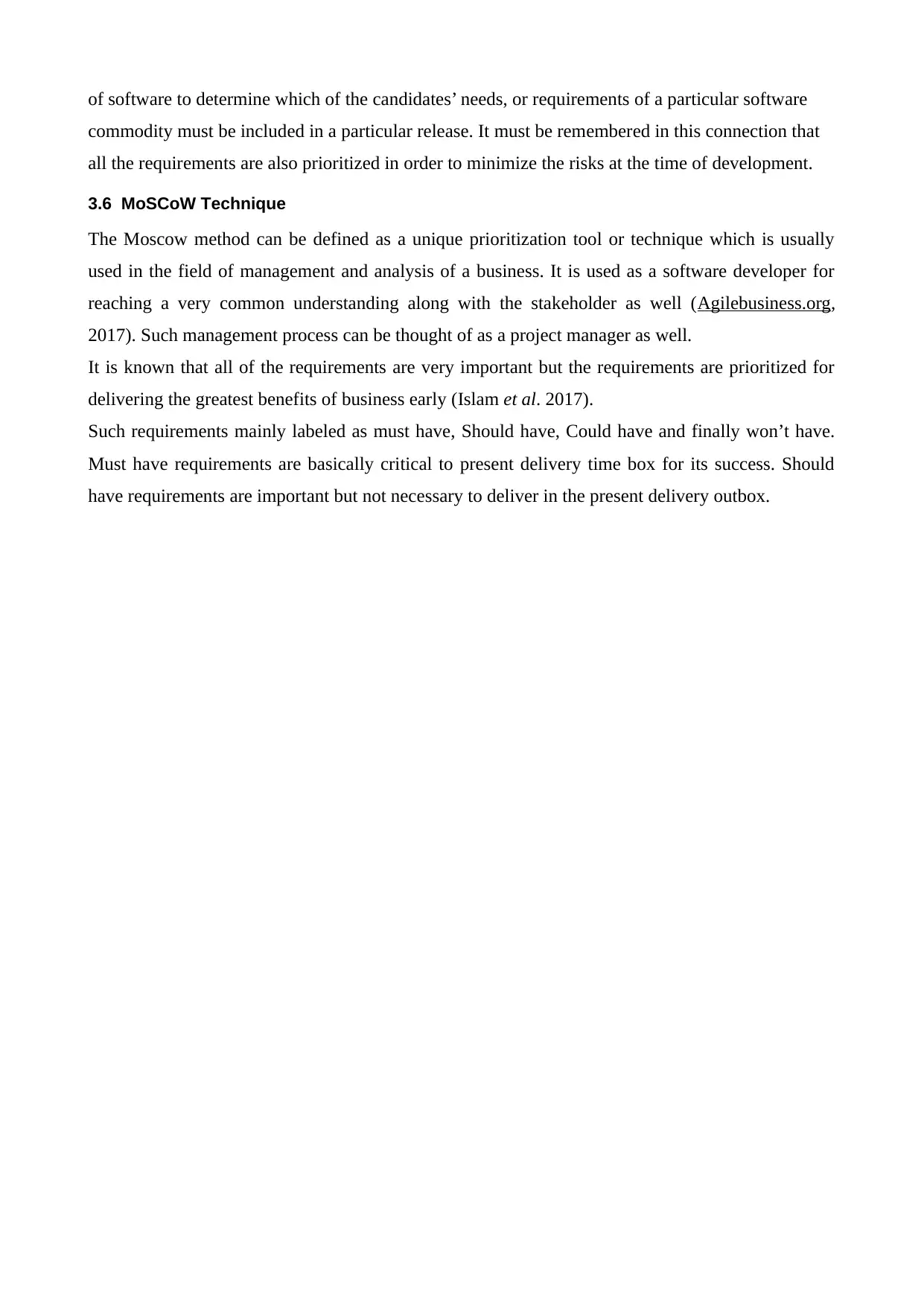
of software to determine which of the candidates’ needs, or requirements of a particular software
commodity must be included in a particular release. It must be remembered in this connection that
all the requirements are also prioritized in order to minimize the risks at the time of development.
3.6 MoSCoW Technique
The Moscow method can be defined as a unique prioritization tool or technique which is usually
used in the field of management and analysis of a business. It is used as a software developer for
reaching a very common understanding along with the stakeholder as well (Agilebusiness.org,
2017). Such management process can be thought of as a project manager as well.
It is known that all of the requirements are very important but the requirements are prioritized for
delivering the greatest benefits of business early (Islam et al. 2017).
Such requirements mainly labeled as must have, Should have, Could have and finally won’t have.
Must have requirements are basically critical to present delivery time box for its success. Should
have requirements are important but not necessary to deliver in the present delivery outbox.
commodity must be included in a particular release. It must be remembered in this connection that
all the requirements are also prioritized in order to minimize the risks at the time of development.
3.6 MoSCoW Technique
The Moscow method can be defined as a unique prioritization tool or technique which is usually
used in the field of management and analysis of a business. It is used as a software developer for
reaching a very common understanding along with the stakeholder as well (Agilebusiness.org,
2017). Such management process can be thought of as a project manager as well.
It is known that all of the requirements are very important but the requirements are prioritized for
delivering the greatest benefits of business early (Islam et al. 2017).
Such requirements mainly labeled as must have, Should have, Could have and finally won’t have.
Must have requirements are basically critical to present delivery time box for its success. Should
have requirements are important but not necessary to deliver in the present delivery outbox.
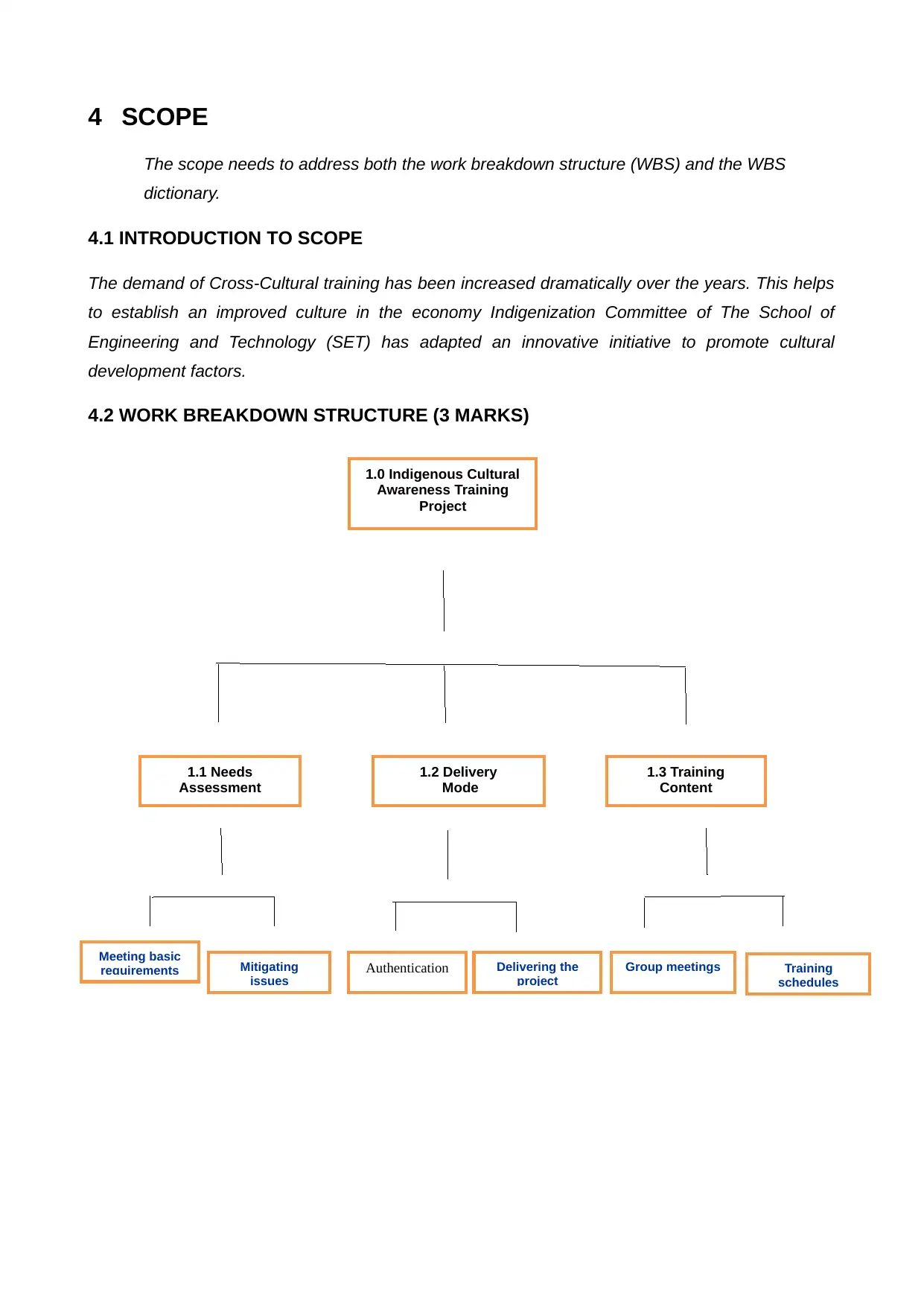
4 SCOPE
The scope needs to address both the work breakdown structure (WBS) and the WBS
dictionary.
4.1 INTRODUCTION TO SCOPE
The demand of Cross-Cultural training has been increased dramatically over the years. This helps
to establish an improved culture in the economy Indigenization Committee of The School of
Engineering and Technology (SET) has adapted an innovative initiative to promote cultural
development factors.
4.2 WORK BREAKDOWN STRUCTURE (3 MARKS)
1.0 Indigenous Cultural
Awareness Training
Project
1.3 Training
Content
1.2 Delivery
Mode
1.1 Needs
Assessment
Training
schedules
Group meetingsDelivering the
project
AuthenticationMitigating
issues
Meeting basic
requirements
The scope needs to address both the work breakdown structure (WBS) and the WBS
dictionary.
4.1 INTRODUCTION TO SCOPE
The demand of Cross-Cultural training has been increased dramatically over the years. This helps
to establish an improved culture in the economy Indigenization Committee of The School of
Engineering and Technology (SET) has adapted an innovative initiative to promote cultural
development factors.
4.2 WORK BREAKDOWN STRUCTURE (3 MARKS)
1.0 Indigenous Cultural
Awareness Training
Project
1.3 Training
Content
1.2 Delivery
Mode
1.1 Needs
Assessment
Training
schedules
Group meetingsDelivering the
project
AuthenticationMitigating
issues
Meeting basic
requirements
⊘ This is a preview!⊘
Do you want full access?
Subscribe today to unlock all pages.

Trusted by 1+ million students worldwide
1 out of 20
Related Documents
Your All-in-One AI-Powered Toolkit for Academic Success.
+13062052269
info@desklib.com
Available 24*7 on WhatsApp / Email
![[object Object]](/_next/static/media/star-bottom.7253800d.svg)
Unlock your academic potential
Copyright © 2020–2025 A2Z Services. All Rights Reserved. Developed and managed by ZUCOL.




